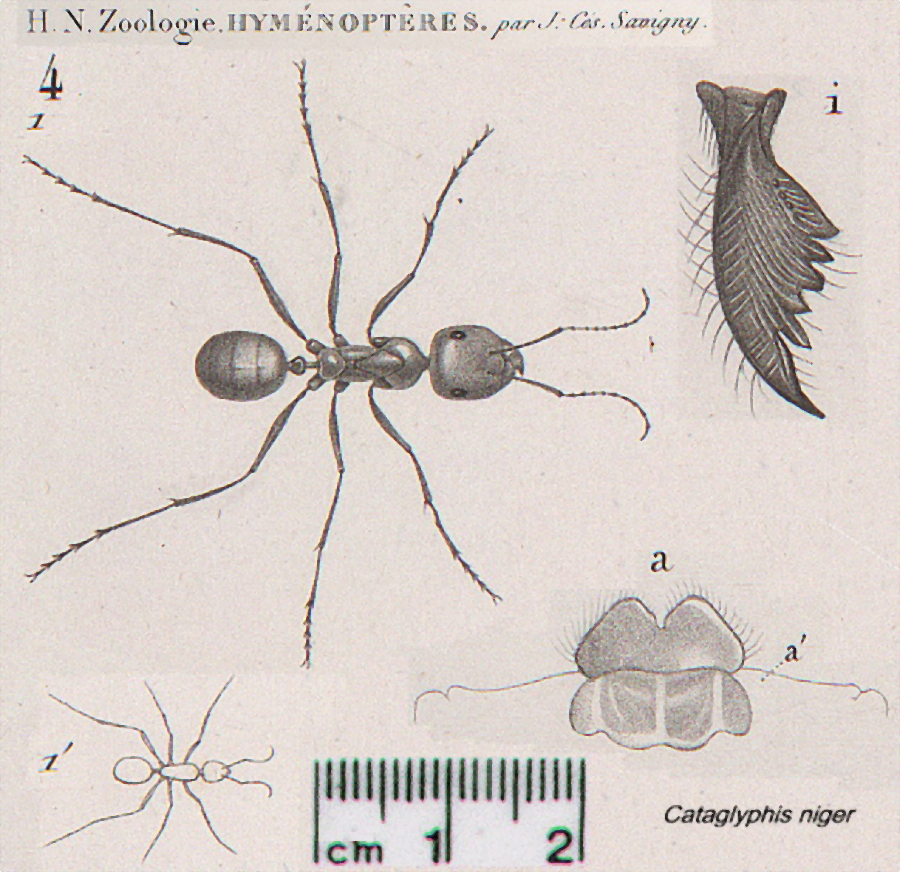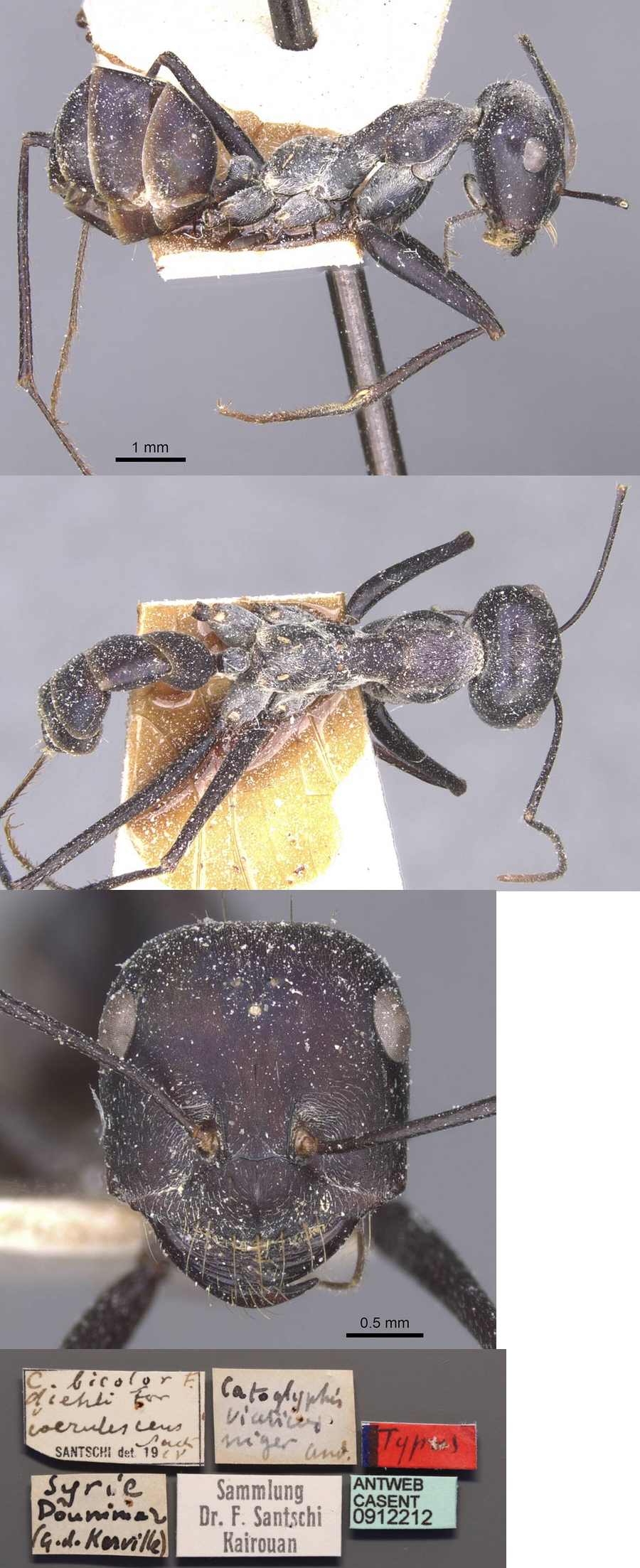Cataglyphis niger (André)

Type location Israel
(Myrmecocystus viaticus var niger, André, 1881b: 56,
worker - illustrated (not seen) but may have been of the viaticus
type; Forel, 1913d: 434, queen; raised to species Collingwood, 1985:
290) - no images on Antweb (March 2019)
unavailable names
pharao (Cataglyphis bicolor F.
stirps nigra André v. pharao n.v., Santschi, 1929b: 51,
worker) from Egypt
- a type minor worker in poor condition can be seen at http://www.antweb.org/specimenImages.do?code=casent0912213.
caerulescens (Cataglyphis bicolor F.
stirps nigra André v. caerulescens n.v., Santschi,
1929b: 50,
worker) from Syria, Doummar [Dummar, Damascus], Gadeau de
Kerville
- see below.
worker and queen only known.
|
André (1881b, illustration unavailable) simply noted
that examples of Myrmecocystus viatica from Beyrouth (Beirut,
Lebanon) and Alexandria (Egypt) had the body colour dull matt
red, with the gaster black, quite shiny; others from Jaffa (Israel)
were entirely black with the gaster matt as with the rest of the body,
the TL was between 5.0 and 12 mm. This he named as the variety niger.
Santschi's (1929b) description is at  . Santschi's (1929b) description of pharao
is at . Santschi's (1929b) description of pharao
is at  . Santschi's (1929b) description of caerulescens
is at . Santschi's (1929b) description of caerulescens
is at  .
Collingwood & Agosti (1996) gave the
note on .
Collingwood & Agosti (1996) gave the
note on  . .
|
 Egypt
records - illustrated by Savigny (Audouin, J.-V. 1825-27: Plate 20
Fig 4). Wheeler & Mann (1916) from Cairo, and Lake Fayum (by Wm.
Granger); Finzi (1936: 193) cited Menozzi (1929: 128) Wadi Scheich and
Wueste Kaa (Sinai); also in Mohamed et al (2001) &
El-Moursy et al (2001). Egypt
records - illustrated by Savigny (Audouin, J.-V. 1825-27: Plate 20
Fig 4). Wheeler & Mann (1916) from Cairo, and Lake Fayum (by Wm.
Granger); Finzi (1936: 193) cited Menozzi (1929: 128) Wadi Scheich and
Wueste Kaa (Sinai); also in Mohamed et al (2001) &
El-Moursy et al (2001).
Egypt records - pharao specimens
described by Santschi (1929b) were from the coastal desert at Suez
(Reichensperger); also noted as from Palestine and all over Egypt by
Mohamed et al. (2001). From the present specimens, their note
of the third maxillary palp lacking long curved hairs seems incorrect.
 Collingwood
(1985) had - petiole a thick rounded node
about as high as
long, first funiculus segment length nearly 2 X second; TL up to 12 mm;
colour mainly black. In Saudi Arabia it was the most conspicuous and
probably largest of the Cataglyphis species, big workers with
HW up to 3 mm and TL 12.5. Abundant in the Middle East and also from
Tunisia. Collingwood
(1985) had - petiole a thick rounded node
about as high as
long, first funiculus segment length nearly 2 X second; TL up to 12 mm;
colour mainly black. In Saudi Arabia it was the most conspicuous and
probably largest of the Cataglyphis species, big workers with
HW up to 3 mm and TL 12.5. Abundant in the Middle East and also from
Tunisia.
|
 The
photomontage
of the caerulescens type is collated from http://www.antweb.org/specimen.do?name=casent0912212.
This matches the minor worker from Iran, shown below. The
photomontage
of the caerulescens type is collated from http://www.antweb.org/specimen.do?name=casent0912212.
This matches the minor worker from Iran, shown below.
|
Oxford University Museum
specimens
Cataglyphis niger
B Taylor det. |
Egypt
M James
2002-05
|
2002
Sinai
28°33' N
33°56' E
|
St Katherine
protectorate around the town of St Katherine, in mountains above 1500m
|
2
|
 |
Cataglyphis niger
B Taylor det. |
Egypt
O Norfolk
01 |
2010
Sinai
28°33' N
33°56' E
|
St Katherine’s
Protectorate
Pitfall trap in wadi garden
|
3
|
 |
|
 The photomontage is of a major workers collected
in the Sinai
Desert, Egypt, St Katherine protectorate around the town of St
Katherine, in mountains above 1500m, in early 2001, by Mike James. The
shiny appearance probably is due to the preserving fluid but they
match the Jaffa (Israel) colour
noted by André. The photomontage is of a major workers collected
in the Sinai
Desert, Egypt, St Katherine protectorate around the town of St
Katherine, in mountains above 1500m, in early 2001, by Mike James. The
shiny appearance probably is due to the preserving fluid but they
match the Jaffa (Israel) colour
noted by André.
|
 The photomontage is of a minor worker in the Sinai
Desert, Egypt, St Katherine protectorate around the town of St
Katherine, in mountains above 1500m; collector Olivia Norfolk (ON 01-1. The photomontage is of a minor worker in the Sinai
Desert, Egypt, St Katherine protectorate around the town of St
Katherine, in mountains above 1500m; collector Olivia Norfolk (ON 01-1.
|
Iran form
 The photomontage is of a
major worker from Iran, Nowdeh, S Aram (20). The photomontage is of a
major worker from Iran, Nowdeh, S Aram (20).
|
 The photomontage is of a
minor worker from Iran, Nowdeh, S Aram (20). The photomontage is of a
minor worker from Iran, Nowdeh, S Aram (20).
|
|